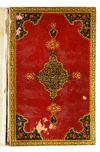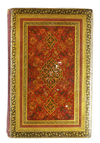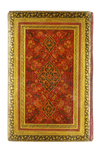AN ILLUMINATED QURAN IN A RICHLY PAINTED FLORAL LACQUER BINDING, RAJAB 1285 AH - RAMADAN 1287 AH/NOVEMBER 1868 - DECEMBER 1870 AD
AN ILLUMINATED QURAN IN A RICHLY PAINTED FLORAL LACQUER BINDING, COPIED BY AHMAD AL-NAYRIZI (DIED 1739 AD), RE-MARGINED IN QAJAR PERIOD AND COMMISSIONED FOR THE LIBRARY OF AMIR-I JANG (HISHMAT AL-DAWLAH), MASHHAD,
An Arabic manuscript on paper, 388 folios, plus 2 flyleaves, 12 lines to a page, written in naskh in black ink, ruled in blue, gold, and red, the external Qajar margins lavishly illuminated with polychrome and gold interlacing scrolls and flowers, verses separated by gold dotted rosettes, surah headings in blue cursive against a gold ground within polychrome cartouches, gold and polychrome verse markers in the margins. List of surahs in red or gold each within geometric against gold and blue ground shapes, around the double-page spread of illumination consisting of a central lobed panel with gold naskh against a red ground, followed by two pages with a polychrome and gold incipit frame, the last page bearing the colophon. A red backed lacquer boards, the outer boards richly decorated with red and yellow flowers and foliage with gold frames or boarders, the inner boards decorated with a central panel within several floral borders.
Re-margined during the Qajar period, the borders of this manuscript are lavishly decorated with different patterns of interlacing flowers and vegetation, making it an exceptionally luxurious manuscript.
The colophon to this Quran states that it was illuminated and had diacritical marks added (tashif) in Mashhad on the orders of Hamzah Mirza Hishmat al-Dawlah. This was the uncle of Nasir al-Din Shah and one of the most prominent military men of the Shah’s reign and variously governor of numerous provinces including Zanjan, Khurasan, Isfahan, Azarbayjan, Yazd, Khuzistan and Luristan. According to the colophon, the original text of the Quran was copied by the famous scribe Ahmad al-Nayrizi.
This colophon is complimented by the information in the cartouche on the inside of the back cover, which is dated Ramadan 1287 AH/ November-December 1871 AD. Here it states that the Quran was bound, burnished, illuminated and gilded for the library of the Amir-i Jang (‘Commander of War’). Though the title Amir-i Jang in some sources is reported to have been awarded to Hishmat al-Dawlah in 1288 in connection with his campaign to Tbilisi to meet the invading Russian army1, this cover indicates that Hishmat al-Dawlah already was using this title by 1287. At the time the manuscript was refurbished, Hishmat al-Dawlah was governor of Khurasan, which explains why the task was completed in Mashhad. The left-hand page of the illuminated frontispiece bears the slightly later date of 1289 AH/1872-3 AD Quran 27 by 17 cm. Text 15 by 9.5 cm
CATALOGUE NOTE Ahmad al-Nayrizi was preeminent calligrapher of the later Safavid period. Born in Nayriz in Fars, he studied under Aqa Ibrahim Qumi (active between 1659 and 1707) and was calligrapher at the court of Shah Sultan Husayn (r.1694-1722) in Isfahan. His work was highly admired both in his own time and throughout the Qajar period, during which time his work was both collected and widely imitated. Very reare examples of Al-nayrizi works can be found. The Metropolitan Museum has got 5 of his important works.










